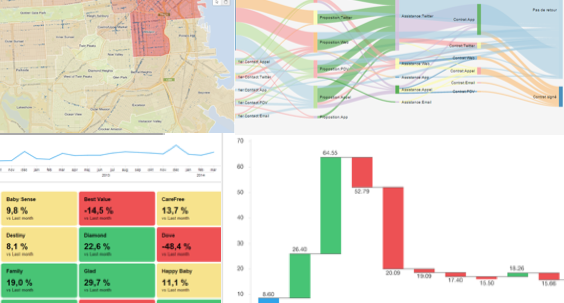y Michael O’Connell, Chief Analytics Officer at TIBCO. Big Data does not convert data into actionable information. Big Data does not create value. But Data Science does, and it does not have to be complex or expensive, or even big. I recently wrote an article on this topic that was published in TechInAsia. The article focuses on Big Data applications in the Asia Pacific region. I am speaking at Strata Singapore on December 8. Here is a shortened version of the article. TechInAsia is a great site – check out their community. For the past few years, Big Data and the Internet of Things (IoT) have been driving the digital revolution toward the “smart everything.” While North America is projected to hold the largest share of the Big Data market, the Asia Pacific region is the fastest-growing Big Data market. Beyond Big Data implementations at the enterprise level, planners and politicians on the largest scale are looking to Big Data to facilitate the creation of “smart cities.” In its “Smart Cities in Southeast Asia” report, PwC highlights the factors that are driving this approach. “Urbanisation,” it says, “is increasing at a rate that will likely result in significant tension; with demand outstripping resource supply, urban planning is becoming critical.” The report states that one critical way that cities will remain liveable is to evolve, through the use of technology, into a so-called “smart city.” This will call for the generation, collection, storage, and analysis of massive amounts of data across power, transport, water and sanitation, and telecoms. The cost, however, will be huge – the Asian Development Bank estimates that between 2010 and 2020 the region would require almost US$600bil in investments across these four sectors. The basic idea behind Big Data and IoT is that everything consumers and businesses do is now leaving a digital trace – which can be turned into smart insight. While this is a great vision, the most important part of the process is often not appreciated, i.e. making actionable information out of the raw data. Qiao Li, Senior Market Analyst, Big Data and analytics at IDC Asia Pacific observes: “One in three organisations in the region find it difficult to build business case or measure ROI while leveraging BDA solutions, and we see organisations are becoming more pragmatic in justifying business cases and starting small in their BDA journey.” What businesses need to understand is this: Big Data does not convert data into actionable information. Big Data does not create value. But Data Science does, and it does not have to be complex or expensive, or even big. Data Science is not just about data scientists, it’s about business acumen and passion Data Science is a three-legged stool that combines business acumen, data wrangling and analytics to create extreme value. Focusing on the hard science skills such as statistical methods is a common mistake when actually, developing the knowledge about a particular business and wrangling the relevant data are often the most important skills to bring to the table. It’s one thing to know how to play with numbers, but it’s more important to understand what insights these numbers reveal on the business, and what actions to take based on these insights. Experience and business knowledge plays a role, as well as curiosity and passion. Sometimes the best results come from unlikely people just because of their desire and persistence. Driving Insights to Actions with Analytics Turning Data into Insights, and Insights into Action is a multi-step process: 1. Ask the right question by deciding which specific business problem to tackle. Make sure you are focused and spend every minute on high value business problems. 2. Sourcing and accessing the appropriate data sources. Organic big data are cheap and non-intrusive, but often not representative to the business problem. Seeking out the best, most representative data is a key initial task. 3. Clean and transform these data sources. Massaging available data to address the business problem is time-consuming but crucial. The best analytics methods can’t make up for poor quality data. 4. Clearly define the response variables and explanatory features that inform the business problem. Crisp definition of variables and features is central to deriving actionable insights. 5. Prepare visualizations and dashboards highlighting the key response variables and features so that everyone can quickly derive insights on the business issues. 6. Create predictive models and rules that encapsulate the insights for ongoing analysis and action. 7. Publish the dashboards, models and rules for ongoing use across the business. 8. Refresh with source data as often as practical for the business problem at hand. Some data don’t change very fast and/or can’t be actioned right away. In other cases, we can drive action intraday or even in the moment. 9. Define alerts and notifications so that appropriate stakeholders are informed when there are opportunities or threats on the business. Each of these steps is rooted in common sense, and keeping intensely focused on the business problem at hand. With this kind of focus, data science drives significant value across industries and functional areas. For business problems where data are in motion, we can get all the way through these 9 steps and drive extreme value to the business. Some examples include: The sheer volume of data strains comprehension – according to Entrepreneur.com, by 2020, every person online will create roughly 1.7 megabytes of new data every second of every day, and that’s on top of the 44 zettabytes (or 44 trillion gigabytes) of data that will exist in the digital universe by that time. Confronted with this tsunami of data, the key to avoiding wasted investment, misguided conclusions, and even terminal panic, is quite simply the application of data science and common-sense business skills to extract value and information from all the available data. And to thereby drive business strategy, tactics and operations through refreshed information; and with relevant business context, in the moment.本帖隐藏的内容






 雷达卡
雷达卡
















 提升卡
提升卡 置顶卡
置顶卡 沉默卡
沉默卡 变色卡
变色卡 抢沙发
抢沙发 千斤顶
千斤顶 显身卡
显身卡










 京公网安备 11010802022788号
京公网安备 11010802022788号







